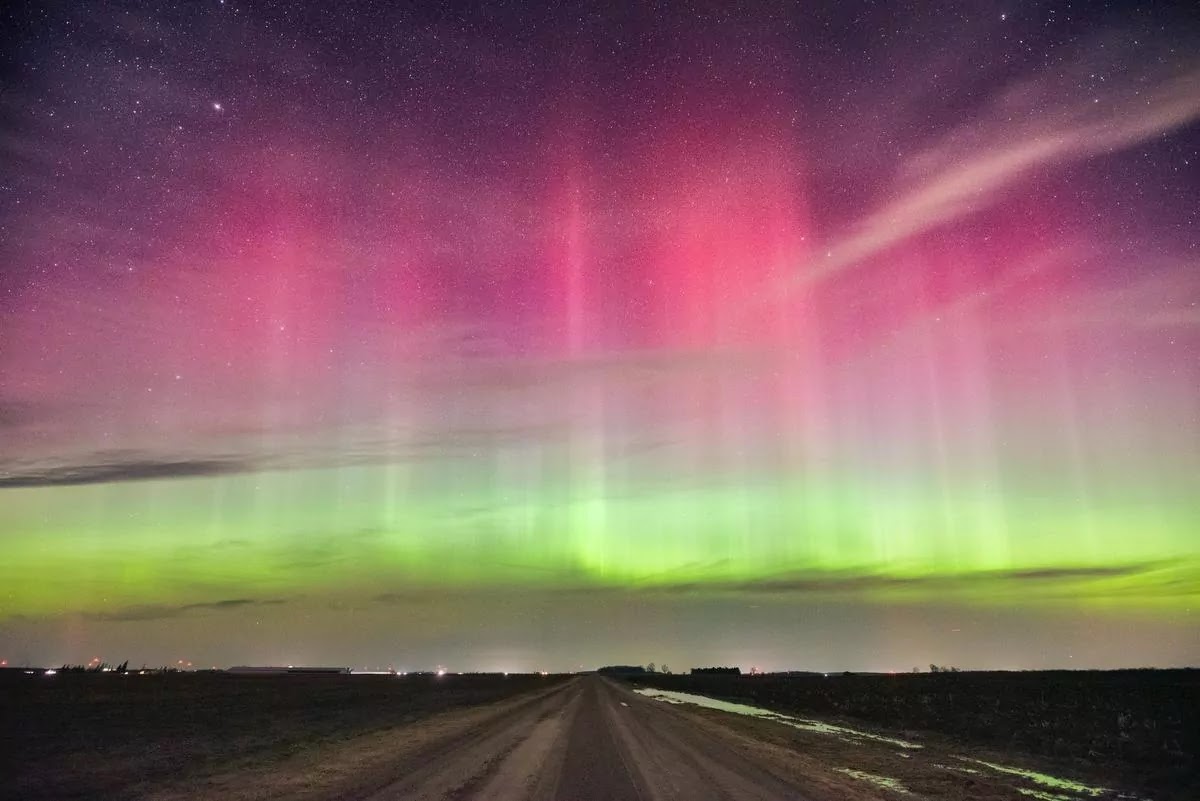


On May 10-11, 2024, a G4 level geomagnetic storm caused by a solar explosion resulted in a spectacular display of northern lights across Canada, the U.S. and Europe. Southern Ontario, which usually does not witness such phenomena, was treated to a rare light show. However, these stunning lights are caused by charged particles hitting Earth's magnetic field and could potentially harm water supplies in cities like North Bay, Ontario. This ordeal raises concerns about the long-term effects of geomagnetic storms on our environment.
The Mystique and Potential Risks of Northern Lights: Unraveling the Impact of Geomagnetic Storms
Background:
The Northern Lights, also known as Aurora Borealis, are a natural light display in the Earth's sky, primarily visible at high latitude regions (around the Arctic and Antarctic). These mesmerizing lights are caused by the interaction between charged particles from the sun entering the Earth's magnetic field.
Solar Explosions and Geomagnetic Storms:
The sun releases a stream of charged particles into space, known as the solar wind. When these particles encounter the Earth's magnetic field, they can get trapped and accelerated towards the magnetic poles. This influx of charged particles creates a geomagnetic storm. The severity of a geomagnetic storm is measured on the G-scale, with G1 being minor and G5 being extreme.
Impacts on Earth:
1. Power Grid Disruptions: Geomagnetic storms can induce large electric currents in power lines, potentially leading to blackouts and damage to infrastructure.
2. Satellite Disruptions: Charged particles can interfere with radio communications, including satellite communication, disrupting navigation and other systems.
3. Water Supply Contamination: Geomagnetic storms can create electrical currents in water pipelines, leading to corrosion and potential water supply contamination.
4. Health Impacts: Some research suggests that geomagnetic storms may trigger cardiovascular problems in vulnerable individuals.
Notable Events:
1. May 10-11, 2024: A G4-level geomagnetic storm resulted in spectacular Northern Lights displays across Canada, the U.S., and Europe. It also raised concerns about potential water supply contamination in Ontario, Canada.
2. October 29, 2003: Known as the "Halloween Storm," this G5-level geomagnetic storm caused widespread power outages in Sweden, disrupted satellite communications, and damaged transformers across North America.
Top 5 FAQs:
1. Can I see the Northern Lights in my location? The Northern Lights are typically visible in higher latitude regions, with the best viewing conditions being around the Arctic Circle.
2. Is it safe to watch the Northern Lights? Yes, watching the Northern Lights is generally safe. However, it's important to check the weather forecast and dress warmly as temperatures can be cold.
3. What causes the different colors in the Northern Lights? The color of the Northern Lights depends on the type of atoms and molecules that the charged particles interact with. Oxygen produces green and red lights, while nitrogen produces blue and purple lights.
4. How can I protect myself from the potential risks of geomagnetic storms? During a geomagnetic storm, it's advisable to stay indoors, unplug electronic devices, and keep emergency supplies readily available.
5. How can we predict when geomagnetic storms will occur? Scientists can monitor solar activity and issue warnings when a geomagnetic storm is likely. However, it's difficult to predict the exact timing and severity of such storms.

As winter arrives in India, so does the hazardous air pollution. Delhi NCR's AQI has already crossed the 400 mark, making it crucial to invest in air purifiers, especially after Diwali. Dyson, Qubo, HomePure, and Philips have launched high-quality air purifiers with advanced features to tackle different types of pollutants and create cleaner indoor air. With prices ranging from Rs 5,000 to Rs 1 lakh, these purifiers are a practical and timely purchase for a healthier living.

In a recent family vlog, Indian celebrity couple Shoaib Ibrahim and Dipika Kakar shared their "natural" hair care routine for their son, using a homemade mask made with rice flour, flax seeds, and coconut oil. However, experts warn that what works for adults may not be suitable for babies, whose sensitive skin and scalp could react to the ingredients. While the ingredients may improve hair texture, they do not necessarily promote hair growth. Instead, a healthy diet and good scalp care are more important in maintaining healthy hair.

A recent consumer study has found multiple brands of soft contact lenses in the U.S. to contain "forever chemicals" that can be harmful to both the body and the environment. The study, conducted by the nonprofit organization Environmental Health Sciences, tested 18 varieties of popular contact lenses and found all of them to contain markers for PFAS. Brands such as Acuvue, Alcon, and CooperVision were among the list of affected products. This news serves as a cautionary lesson on the potential risks of overusing contact lenses.

On the birth anniversary of Dr. APJ Abdul Kalam, the ‘Missile Man’ of India, tributes pour in on social media celebrating his life, vision and impact. A visionary scientist, inspiring leader and true patriot, Dr. Kalam's humility, compassion and constant interaction with students continue to inspire generations. His tireless efforts in defense, science and youth empowerment have strengthened India's path towards self-reliance and his legacy continues to motivate young minds to dream big and work hard for the nation.

Recent studies have found that extreme heat, particularly when combined with high humidity, can have a significant impact on mental health. A study in India showed that when wet bulb temperature exceeded 27°C, the probability of reporting severe depression increased by 0.5%, even when the temperature was slightly lower. This finding is consistent with global reviews that have linked high temperatures to mood disorders, increased hospital admissions for psychiatric conditions, and even elevated suicide risk. The Lancet has also published evidence that rising temperatures worldwide are a growing threat to emotional and cognitive health.

In a meeting with university officials in Udaipur, Rajasthan Governor Hari Bhau Bagde stressed the importance of incorporating India's ancient knowledge traditions into academic research. He highlighted the deep repository of knowledge in India since ancient times and urged scholars and scientists to draw upon this tradition in their work. Bagde also suggested making ancient texts available in university libraries for study and research purposes, in order to shape the intellectual abilities and love for the nation among the younger generation.

John Clarke, Michel H. Devoret, and John M. Martinis have been awarded the 2025 Nobel Prize in Physics for their pioneering research into quantum mechanical tunnelling. Their discovery has opened new possibilities for quantum technologies, and will be formally presented on December 10, the anniversary of Alfred Nobel's death. This announcement follows the tradition of recognizing transformative contributions to science, and the award carries a prestigious prize of 11 million Swedish kronor.

The US-Japanese trio of Mary E Brunkow, Fred Ramsdell, and Shimon Sakaguchi have won the 2025 Nobel Prize in physiology or medicine “for their discoveries concerning peripheral immune tolerance". Through their research, they have shown how the immune system is kept in check and why serious autoimmune diseases do not affect everyone. Sakaguchi found a new class of T cells, while Brunkow and Ramsdell discovered the explanation behind a specific mouse strain's vulnerability to autoimmune diseases. Together, they have significantly advanced our understanding of immunology and autoimmune diseases.

Indian astronaut Shubhanshu Shukla, who recently completed a 20-day space mission, shared his insights and experiences at the convocation ceremony of Dr. APJ Abdul Kalam Technical University. He highlighted the importance of patience, focus, and the inevitability of change in achieving success, and urged the graduating class to actively contribute to shaping a fearless and ambitious India.

The Regional Meteorological Centre (RMC) in Chennai has issued a weather alert for parts of Tamil Nadu, with thunderstorms and light to moderate rainfall expected on Saturday. The alert was issued due to the strengthening of a cyclonic circulation in the Bay of Bengal, which is likely to intensify and form a low-pressure area. The system is expected to affect Tamil Nadu, Puducherry, and Karaikal, with some areas experiencing heavy rainfall and gusty winds. The public is advised to stay updated and take precautions, especially in hilly and western districts.